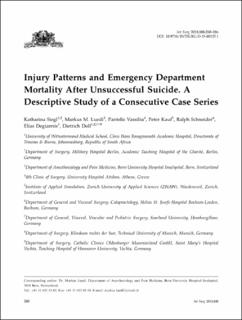Please use this identifier to cite or link to this item:
https://doi.org/10.21256/zhaw-28740Full metadata record
| DC Field | Value | Language |
|---|---|---|
| dc.contributor.author | Siegl, Katharina | - |
| dc.contributor.author | Luedi, Markus M. | - |
| dc.contributor.author | Vassiliu, Pantelis | - |
| dc.contributor.author | Kauf, Peter | - |
| dc.contributor.author | Schneider, Ralph | - |
| dc.contributor.author | Degiannis, Elias | - |
| dc.contributor.author | Doll, Dietrich | - |
| dc.date.accessioned | 2023-09-22T12:41:51Z | - |
| dc.date.available | 2023-09-22T12:41:51Z | - |
| dc.date.issued | 2018 | - |
| dc.identifier.issn | 0020-8868 | de_CH |
| dc.identifier.issn | 2520-2456 | de_CH |
| dc.identifier.uri | https://digitalcollection.zhaw.ch/handle/11475/28740 | - |
| dc.description.abstract | We hypothesized that trauma bay management and 24-hour emergency department (ED) mortality of patients that survived unsuccessful suicide attempts differ from other patients. Severely injured patients after an unsuccessful suicide attempt can be admitted to resuscitation rooms of any ED. To our knowledge, 24-hour mortality has not been investigated yet. We studied such patients admitted to the resuscitation room of a large ED. This consecutive case series included 64 patients who were evaluated in the resuscitation room because of an unsuccessful suicide attempt. Patient variables were recorded including method of suicide attempt, injuries, hemodynamic status, and treatment. Most patients were male [57 patients (89%)], and the most frequent methods were ingestion of harmful devices or substances [15 patients (23%)]; hanging [9 patients (14%)]; and strangulation [9 patients (14%)]. There were 2 patients who died in the ED: 1 from a self-inflicted gunshot to the head and the other from self-inflicted herbal poisoning. The frequency of emergency airway intervention was greater in patients after unsuccessful attempted suicide [18 patients, 28% (95% confidence interval [CI], 17.2%, 39%; endotracheal intubation, 17 patients; emergency tracheotomy, 1 patient] than all ED patients [1458 patients (16%); (95% CI, 14.9%, 16.4%; P = 0.005)]. Following attempted survived suicide, 24-hour ED mortality was 3% and 4% within the control group; the difference is insignificant (P = 0.9596). However, ED mortality showed a trend toward earlier death within the suicidal group. Resuscitation room mortality of patients that survived unsuccessful suicide does not differ from the general population of an ED resuscitation room. | de_CH |
| dc.language.iso | en | de_CH |
| dc.publisher | International College of Surgeons | de_CH |
| dc.relation.ispartof | International Surgery | de_CH |
| dc.rights | https://creativecommons.org/licenses/by-nc/3.0/ | de_CH |
| dc.subject | Psychiatry | de_CH |
| dc.subject | Emergency care | de_CH |
| dc.subject | Trauma | de_CH |
| dc.subject | Intubation | de_CH |
| dc.subject | Treatment | de_CH |
| dc.subject | Mortality | de_CH |
| dc.subject.ddc | 616: Innere Medizin und Krankheiten | de_CH |
| dc.title | Injury patterns and emergency department mortality after unsuccessful suicide : a descriptive study of a consecutive case series | de_CH |
| dc.type | Beitrag in wissenschaftlicher Zeitschrift | de_CH |
| dcterms.type | Text | de_CH |
| zhaw.departement | Life Sciences und Facility Management | de_CH |
| dc.identifier.doi | 10.9738/INTSURG-D-15-00125.1 | de_CH |
| dc.identifier.doi | 10.21256/zhaw-28740 | - |
| zhaw.funding.eu | No | de_CH |
| zhaw.issue | 5-6 | de_CH |
| zhaw.originated.zhaw | Yes | de_CH |
| zhaw.pages.end | 286 | de_CH |
| zhaw.pages.start | 280 | de_CH |
| zhaw.publication.status | publishedVersion | de_CH |
| zhaw.volume | 103 | de_CH |
| zhaw.publication.review | Peer review (Publikation) | de_CH |
| zhaw.author.additional | No | de_CH |
| zhaw.display.portrait | Yes | de_CH |
| Appears in collections: | Publikationen Life Sciences und Facility Management | |
Files in This Item:
| File | Description | Size | Format | |
|---|---|---|---|---|
| 2018_Siegl-etal_Injury-patterns-and-emergency-department-mortality-after-unsuccessful-suicide.pdf | 183.49 kB | Adobe PDF |  View/Open |
Show simple item record
Siegl, K., Luedi, M. M., Vassiliu, P., Kauf, P., Schneider, R., Degiannis, E., & Doll, D. (2018). Injury patterns and emergency department mortality after unsuccessful suicide : a descriptive study of a consecutive case series. International Surgery, 103(5-6), 280–286. https://doi.org/10.9738/INTSURG-D-15-00125.1
Siegl, K. et al. (2018) ‘Injury patterns and emergency department mortality after unsuccessful suicide : a descriptive study of a consecutive case series’, International Surgery, 103(5-6), pp. 280–286. Available at: https://doi.org/10.9738/INTSURG-D-15-00125.1.
K. Siegl et al., “Injury patterns and emergency department mortality after unsuccessful suicide : a descriptive study of a consecutive case series,” International Surgery, vol. 103, no. 5-6, pp. 280–286, 2018, doi: 10.9738/INTSURG-D-15-00125.1.
SIEGL, Katharina, Markus M. LUEDI, Pantelis VASSILIU, Peter KAUF, Ralph SCHNEIDER, Elias DEGIANNIS und Dietrich DOLL, 2018. Injury patterns and emergency department mortality after unsuccessful suicide : a descriptive study of a consecutive case series. International Surgery. 2018. Bd. 103, Nr. 5-6, S. 280–286. DOI 10.9738/INTSURG-D-15-00125.1
Siegl, Katharina, Markus M. Luedi, Pantelis Vassiliu, Peter Kauf, Ralph Schneider, Elias Degiannis, and Dietrich Doll. 2018. “Injury Patterns and Emergency Department Mortality after Unsuccessful Suicide : A Descriptive Study of a Consecutive Case Series.” International Surgery 103 (5-6): 280–86. https://doi.org/10.9738/INTSURG-D-15-00125.1.
Siegl, Katharina, et al. “Injury Patterns and Emergency Department Mortality after Unsuccessful Suicide : A Descriptive Study of a Consecutive Case Series.” International Surgery, vol. 103, no. 5-6, 2018, pp. 280–86, https://doi.org/10.9738/INTSURG-D-15-00125.1.
Items in DSpace are protected by copyright, with all rights reserved, unless otherwise indicated.